Mushrooms
Species Types
Scientific Name
Amanita flavoconia
Description
The cap of this mushroom ranges from orange to yellow, with yellowish patches. The stalk has crumbling patches at the base, and a ring. It grows on the ground in mixed woods.
Media

Species Types
Scientific Name
Galiella rufa (formerly Bulgaria rufa)
Description
The hairy rubber cup has a reddish to brownish inner surface; the outside is blackish brown and hairy. It grows in clusters on dead deciduous wood.
Media

Species Types
Scientific Name
Sarcoscypha occidentalis
Description
The stalked scarlet cup is, indeed, a tiny red cup on a tiny white stalk. It grows scattered on fallen wet sticks and branches in damp deciduous woods.
Media
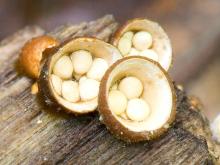
Species Types
Scientific Name
Crucibulum laeve
Description
Splash cups have small brown cups holding tiny “eggs” that are each attached to the “nest” by a cord. They grow in clusters on dead wood, debris, wood chips, and mulch.
Media

Species Types
Scientific Name
Lycoperdon perlatum
Description
The gem-studded puffball is a white, rounded to turban-shaped ball, densely covered with spiny warts, developing a pore at the top. It grows on the ground in open woods, along roads, in waste areas.
Media
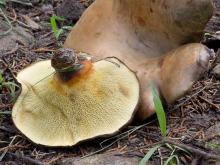
Species Types
Scientific Name
Boletinellus merulioides
Description
The ash tree bolete is a pored mushroom with a brownish, wavy cap, an off-center stalk, and clearly defined pores. It grows scattered on the ground near ash trees.
Media
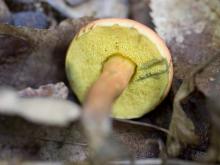
Species Types
Scientific Name
Boletus bicolor
Description
The two-colored bolete has a rose red cap that is sometimes yellowish toward the margin. The underside has tiny yellow pores, and the stalk is reddish yellow; all parts slowly bruise blue. Grows singly or in groups of up to several, on the ground under oaks.
Media
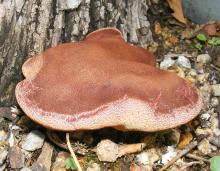
Species Types
Scientific Name
Fistulina hepatica
Description
The beefsteak polypore is a thick, semicircular, reddish or rusty, gelatinous bracket with a pinkish yellow underside. It grows at the base of living oaks and on stumps.
Media
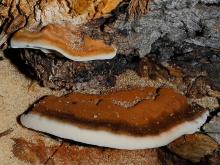
Species Types
Scientific Name
Ischnoderma resinosum
Description
The resinous polypore is a large, thick, velvety, brownish bracket fungus with a thick margin and whitish pores. It grows on logs and stumps of deciduous trees.
Media

Species Types
Scientific Name
Ganoderma sessile (formerly G. lucidum)
Description
The ling chih is a hard, usually flat, zoned bracket fungus with a reddish brown, shiny top. It grows at the base of living and dead deciduous trees, and also around stumps.
See Also



Media

Species Types
Scientific Name
Monotropa hypopitys
Description
Pinesap is a plant that puts the "wild" in wildflower! It lacks chlorophyll, so its roots connect to fungi underground and absorb nutrients from the fungi.
Media

Species Types
Scientific Name
Cladophora, Pithophora, and Spirogyra spp., and others
Description
Filamentous green algae forms green, cottony masses that are free-floating or attached to rocks, debris, or other plants.
Media

Species Types
Scientific Name
Monotropa uniflora
Description
Indian pipe lacks chlorophyll, so it is white, not green. Below ground, its roots join with fungi that connect to tree roots. This plant, then, takes nourishment indirectly from the trees.
About Mushrooms in Missouri
Mushrooms are a lot like plants, but they lack chlorophyll and have to take nutrients from other materials. Mushrooms are neither plants nor animals. They are in a different kingdom — the fungi. Fungi include the familiar mushroom-forming species, plus the yeasts, molds, smuts, and rusts.
Always be cautious when eating edible mushrooms. Be absolutely sure of the ID, and only eat a small amount the first time you try it to avoid a reaction..





















